Back in June the run of red salmon in the Copper River this year was predicted to be poor. And the Miles Lake sonar showed that this was indeed the case, so the Department of Fish and Game closed the season very soon after opening it. And then they kept it closed for most of June and July, with just five open periods of 24-96 hours. The king salmon run was reported to be good, and those who went in June generally caught more than they could keep (1 each). But red fishing was poor.
Then a second pulse of largely hatchery fish was reported to be pretty good. But the water was so high that there were few accessible spots for the charters to drop people, and fishing remained less than stellar. The river got so high one week that the charters closed for safety. The pictures they posted were grim. I was beginning to wonder whether I’d get out before having to travel for a meeting. I left my calendar open for several weeks so I could make a run, but each opening period looked like it would not be a good time for fish. Last year I’d gone on 17 August, my latest ever, and had done fairly well. This year my time available got so squeezed this late in the season that there were only two days that I could do it, the 16th or 17th, and it was still unclear how good or bad fishing might prove to be. It was closed Monday-Wednesday of that week, and the reports from the last weekend were modest, so it was a real risk to aim for the Thursday or Friday opening.
But on the night of the 14th, I said to Rose, “I know how many I’ll get if I don’t go.”
Rose couldn’t go, so on Wednesday morning I packed up and headed out alone. I left earlier than usual because I thought there might be a lot of folks eager to get some fish and, like me, running out of time to do it. It’s a 6-7 hour drive, depending on weather and road construction, and I zoomed. Other than a stop for gas, my only delay was stopping in at Delta Junction’s grocery store. Latvian smoked sprats and pickled garlic for the local Russian market are two things Rose and I enjoy from there that we can’t get in Fairbanks. Loaded up with these, the trip was sure not to be a total bust.
I arrived at O’Brien Creek in the early afternoon. There were far fewer people there than I’d anticipated, so I dropped my life jacket in the developing line and knew I’d get out on one of the first boats the next morning. Then I took a nap. With the season still closed, that evening there was a considerable amount of milling around in the parking area with people wondering how the fishing would be when it opened the next morning. Usually you have a hint by that day’s activity. The water was still pretty high, but the weather was decent, with a cool overcast and no rain. I went to bed early. No matter what happened, tomorrow would be a long day.
This late in the year it’s still dark at 0500, so the charters don’t leave until 0600, though they recommend you be in line at 0545. But some people didn’t know of this late-season change. So, while I’d set my alarm for a conservative 0445, the noise of people arriving at 0420 woke me up. (Aside: has anyone ever heard a car alarm going off for an actual theft, rather than a mistake?) It didn’t take long to get my gear in order and dress warmly. Like yesterday, we had a cool overcast and no rain. I remembered that 364 days ago there had been fresh snow on the local mountaintops.
Mark Hem gave the first 12 of us the standard spiel: five fish per stringer, watch out for steelhead now and release them, the river is high, there are not many spots available, etc. Then he collected our $120-per-person fee and reminded us that it would be an additional $20 if we got 26-35 fish. A household of two can catch up to 35 fish on the Chitina Personal Use Dip Net permit. Because there were few spots, they could not afford to put singles like me alone on a rock. So two of us were paired together. Bill is a retired gentleman from Anchorage and, like me, had just come as a last-minute decision because this year’s chances were running out. He proved to be the most prepared fisherman I’ve seen here.
We were soon off in Sam McCallister’s boat with his brother Roger as crew. Bill and I were dropped in the canyon at a place Roger said they were calling “Killer Rock.” That sounded great to Bill and me. I got my net tied off fairly quickly, and while Bill arranged his gear I dipped my net into the river to get a feel for how things were running. Boom. I had a red salmon in about a minute. And so we were off.
Sam had recommended that Bill and I team up and use one net on this one hot spot and cooperate. Between the two of us, we had a limit of 70 fish, and we agreed that at the end of the day we’d split whatever we caught. Things proved to be hot and heavy, so we did our best to keep a net in the water as much as possible while the fish were running so well. We went at it at a furious pace: net, bonk, clip, and string. Whatever needed doing, one of us would leap to it. Net in the water, club the caught ones on the head to stop them from madly flopping, clip a gill to bleed them and then both tail tips as required by law. Then onto a stringer when we had a little time. We were catching them fast, and it was a nice cool day, so we didn’t actually put the stringers in the water. We debated whether it was easier to clean blood off the fish at the end of the day or to de-silt them if they’d been on a stringer in the water for hours. Tough call. Today it was blood. And more and more of it.
Soon I caught two in the net at once—woohoo! Then three!! I also caught a big steelhead and several Dolly varden. Only salmon are legal, so these other species of trout went back in. After an hour we were up to 30 fish already, and they weren’t slowing down. Sam came by and gave us a big smile at the news.
The fish were not hitting the net hard, so it was often difficult to know if you had one or not (the river is totally opaque with silt). Periodically you’d feel a sort of slump, but often you just had to pull the net up to see if you had a fish. I tended to keep the net in place maybe a little longer than I should have, which is why I caught so many multiples. Soon I caught another three in the net at once (one was another big steelhead), and then I pulled in my first ever four! Wow. I had to stop and take a picture of that. Stunning.
I was laughing in delight at the great day of fishing we were having and without thinking said “The only way to improve on this would be to get a king!”
I realized as the thought tumbled out that I’d probably just jinxed that low possibility and effectively made it impossible. But in a couple minutes I felt a decidedly large slump, and sure enough—a big king salmon! This is really late for kings, but this one looked nice, not beat up but still quite fresh looking. This year’s king run had been good on the Copper River, and I guess maybe the high water had held some back still. Anyway, I was amazed to have caught such a nice fish. Once it was subdued, we got a couple pictures. Then we polished off the remainder of our combined limits. I didn’t note the time when we started, but it took us a little over three hours and less than 3.5 to get both of our limits. It was the best fishing I’ve ever experience on the Copper River. Amazing. We were very happy, and we sat down and ate our lunch while we waited for a pickup.
Sam was busy bringing other successful fishers back to O’Brien Creek, so he radioed Daniel, who was the captain on Mark Hem’s boat this year. The two have worked together for years. Most people were catching a lot of fish, so the boats were quite busy. Daniel picked us up and then two other groups, and we rode in with the most fish I’ve ever been aboard with. Everyone was happy with what they’d caught.
We arrived back at O’Brien Creek at about 1130 and were soon at the fish cleaning station. It seemed that this was the best fishing they’d seen in years, and to my surprise there were not enough people in line to keep these great spots filled. Bill and I congratulated ourselves that we’d guessed on the timing and hit it right. Because it had been cool, shady, and fast, we’d never put our stringers in the water. This made cleanup a little easier, but it was still two hours before I had my half of our fish gutted, washed up, and on ice. I said my goodbyes, packed it all up, and headed north, hoping to make it home still that day. And I did, pulling in at ~2045 and having a late dinner with Rose. What a day!
The next day also proved more interesting than anticipated. I had to get a lot of work done before traveling for my meeting, so I decided to cheat and take some of this big pile of fish to Interior Fish Processing and have them filet and vacuum pack it.
But to my surprise, when I got there they said “No fish!”
Shoot. They were slammed with caribou. Apparently the hunting had been good on the Forty-mile caribou herd this season. I went home, put everything back on ice, then gave Rose a call to let her know we’d be spending more quality time than we’d planned cleaning fish.
We both had to work that afternoon, so it was after a superb dinner of a whole smoke-grilled fresh red salmon that we set the kitchen up for large-scale fish processing. We like doing it in our kitchen because we can keep the meat very clean. And while I’d hoped to not do quite so much, once we’re in the groove it’s a lot of fun putting all that beautiful meat into the freezer. We were up that night until 2300 and finished everything up the next morning.
We held out a couple of pieces of the king and had those smoke-grilled that night and the next. We also cooked up the king salmon head and carcass, picked the meat, concentrated the broth, then froze them so we could make king salmon head bouillabaisse later. We hadn’t had it for several years, and it’s one of our favorites.
King salmon runs across the state have generally not been good in recent years. Back in July I’d stopped at the Healy grocery store on my way into the field and saw an interesting side-by-side comparison. They had frozen alligator from Louisiana for $21/lb. and king salmon from Alaska for $23/lb. Now we love Copper River red salmon, but I have to say that having fresh, smoke-grilled king now and again is like a whole other piece of culinary heaven.
Fish math: While you are always tempted to mentally convert your fish to its dollar value, you have to temper this with two facts: you can’t sell it (it’s a personal use fishery), and when you get your limit you have more fish than you’d probably ever go out and buy. But you do keep track of the numbers. It’s 652 miles round-trip for us to O’Brien Creek. From this trip we wound up with ~120 lbs. of salmon filets in the freezer. Red salmon filets were ~13/lb. and king ~$23/lb. at the store. That’s a lot of fish, and we’ve adapted easily to eating this much during the course of the year. We just love it.
King salmon head Bouillabaisse
 Simmer 1 king salmon head and skeleton in water with some thyme, bay leaf, salt, and pepper. Cool, pick meat, discard bones and skin. Hold meat out. Simmer for several hours to concentrate the broth down to about 4 quarts, then add about 1 C each of wild rice and barley. After half an hour more of simmering, add carrots, celery, onions, garlic, fish sauce, white wine, V8, sliced mushrooms, and salt and pepper to taste. In the last 10 minutes, add back in the meat. Serve in a bowl and sprinkle on chopped scallions and freshly grated parmesan cheese. This is a thick, delicious stew that’s even better on the second and third days. We’ve also had it with roasted garlic and served over baby asparagus.
Simmer 1 king salmon head and skeleton in water with some thyme, bay leaf, salt, and pepper. Cool, pick meat, discard bones and skin. Hold meat out. Simmer for several hours to concentrate the broth down to about 4 quarts, then add about 1 C each of wild rice and barley. After half an hour more of simmering, add carrots, celery, onions, garlic, fish sauce, white wine, V8, sliced mushrooms, and salt and pepper to taste. In the last 10 minutes, add back in the meat. Serve in a bowl and sprinkle on chopped scallions and freshly grated parmesan cheese. This is a thick, delicious stew that’s even better on the second and third days. We’ve also had it with roasted garlic and served over baby asparagus.

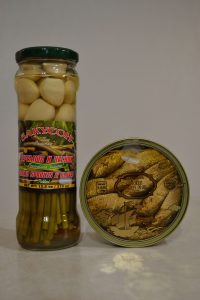
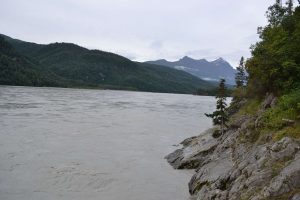
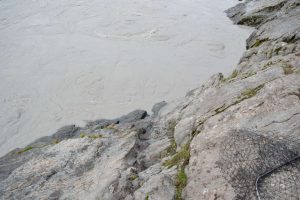
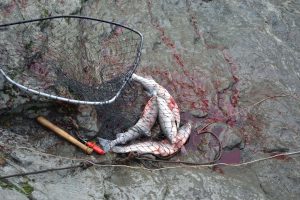
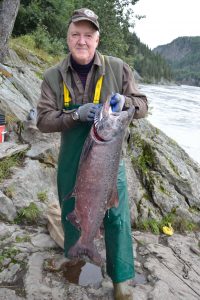
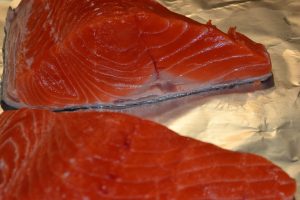
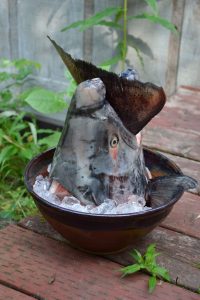
Sounds delicious!
LOVE the story and am tired just reading – I think I need a nap now.